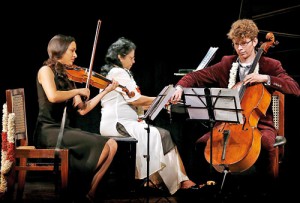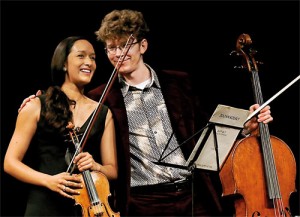Three musicians on a unifying musical journey
“I used to have this idea that I was just a cellist. Just a cellist,” he says, face set. But over the period of his still young career, the horizons have broadened magnificently for Joshua Roman.

Letting themselves go with the music (left to right): Mandhira, Ramya and Joshua. Pix by M.A. Pushpa Kumara
Called (unceasingly it seems) the “rockstar” of classical performance, over the last near-decade, the 31-year-old American cellist has been making a name for himself as an “explorer”. Venturing off the beaten path of concerts and symphony performances, onto non-traditional platforms and cross-medium collaborations, he is on a quest to bring classical music out of its straitjacket into the real world we occupy today.
He plays solo cello, and with ensembles and orchestras. He also composes for cello and ensemble, conducts ensembles and orchestras, and makes home-videos. He performs with actors, visual artists and even chocolatiers. He YouTubes, blogs and masterminds cross-medium creative ventures. TED Fellow and genius in general, Joshua Roman is far from “just a cellist”.
“Right now, I have this particular struggle with trying to figure out how to get people to understand what it is I do,” he says, slightly bemused.
Sri Lanka last heard Joshua Roman live in 2011 when he played two shows in Colombo and then Kandy, with pianist Eshantha Peiris. In the three-and-a-half years since, exposure to a wide range of audiences and performance situations has shifted Roman’s focus from building a career to sharing a “broader and deeper” message.
On the night of Friday, February 13, Joshua Roman played three sets of pieces as part of the programme for ‘Cello Conversations with Sri Lankan Contemporary Art’ at the Saskia Fernando Gallery. He was just recovering from a bout of ‘flu and only a few hours out of the gruelling cross-

Something clicked: Mandhira de Saram and Joshua Roman acknowledge the audience
Atlantic plane ride, but that did not prevent the intensity and weight of his emotional engagement with the pieces, and by extension the works of art on display in the performance space, from infecting his select audience.
The performance that evening was characterised by an intensity and seriousness of emotional engagement which was evident again at his performance with violinist Mandhira de Saram and pianist Ramya Perera on Sunday, February 15 at the Lionel Wendt. theatre.
Mandhira de Saram graduated from the University of Oxford with first class honours and prizes for violin performance and the arts. She has travelled the globe with her music, impressing audiences and working with musicians from classical as well as contemporary and electronic art backgrounds. Her main focus, currently, is building repertoire and reputation with the Ligeti Quartet which is fast becoming known in the UK, where she lives, for its relevant engagement with contemporary music.
The multifacetedness of her career does not so much create a struggle for Mandhira, unlike for Joshua, but she is amused by it.
“It’s funny how minds work,” she smiles, “you have to categorise… Put everything together in a package.” She does not protest this demand made of her as a musician and performer, but rather embraces it in a seeking. “It is after all, all me,” she points out with a shrug.
While the intensity of Roman’s performance was more inward-bound, de Saram’s was much more visibly expressed. Roman, interested in a true-to-ideal performance focused on the dramatic lyricism of Zoltan Kodaly’s Duo for Violin and Cello, which he interprets as “focussed,” and “upright,” containing an “element of pride”. De Saram on the other hand, was “very aware” that the piece was “new for the audience”. “So the important thing is, being able to communicate something,” she says. The difference in the two performers’ approach, though it spells a risk of pulling the text apart, in fact seemed to create just the right balance of push and pull. The performance echoed and complemented the dialogic structure and what de Saram calls “linguistic” or “speaking” nature of the piece, drawing the listener in.
If the contained, beautifully controlled Kodaly made the audience sit up straighter, the explosive colour and “defiant” jubilation of Shostakovitch’sTrio No.2 must have brought them to the edge of their seats.
“For me it was fantastic,” Ramya de Livera enthuses. “I had to have my wits about me,” she laughs, explaining the technicalities of the piano part, “but I just let myself go with the music.”
Ramya de Livera Perera is not just a pianist but also violinist and soloist with the Symphony Orchestra of Sri Lanka, and a highly sought-after piano and violin instructor. She too has had her fair share of exposure on the international stage, yet remains pleased with the simple rewards of teaching music. After a short period of absence from the classical stage, Ramya returned for her performance with Roman and De Saram, simply excited to be working with younger artists from a different generation.
“It was great working together,” she smiles. At times, collaboration means that “one person will want to get a particular idea across” and others will be compelled to follow, Ramya explains. But in this situation “it didn’t feel like that”. Most often, she says, herself, Roman and de Saram were in agreement.
They were able to work only four or five hours together before the concert, but obviously something clicked. The action, excitement and rhythmic force of the Shostakovitch were not dropped for a moment. Joshua’s driving intensity, Mandhira’s bursting passion and Ramya’s confident control set the piece aflame and yet kept it from tearing itself apart in frenzy. This balancing act, this companionship of complementing each other is the greatest reward of such collaboration.
“It’s not just about finding common ground,” as Mandhira points out, “but about finding a common language.”
And for the opportunity for a Sri Lankan audience to experience such a powerful collaboration, the organiser, Sunera Foundation, must be thanked and applauded.


